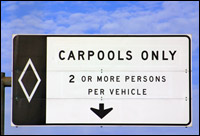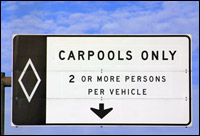Even before last month’s Gulf Coast catastrophes sent the nation’s oil companies scurrying to hike gas prices, the cost of driving to work was nearing the pain point. And not just the price of filling up: as average commute times have grown over the past five years, even in green-minded cities like Portland, Ore., and Boulder, Colo., the economic, environmental, and psychic costs of commuting by car have been anything from a mere headache to a major migraine.

It just makes cents.
As a result, teleworking, carpooling, and other commuting alternatives are undergoing a revival, much as they have during other gas-price spikes. But this time, it’s not just personal — it’s business. Companies are finding that there’s a strong bottom-line case for encouraging employees to spend less time participating in one of the great misnomers of our age: “rush hour.”
At Aetna’s West Region headquarters in San Ramon, Calif., employees who carpool five days a week can earn paid time off. In Seattle, Alaska Airlines offers employees free transit on buses and commuter trains and monthly subsidies for carpools and vanpools. Boulder offers tax-free bus passes to city employees, and free parking for those using vanpools or carpools. Nike conducts drawings for employees who commute by means other than a single-occupancy vehicle, with such prizes as maid service for a day and weekend getaways. Wyeth BioPharma offers on-site facilities for biking and walking commuters, including showers and dry cleaning. And Calvert, the mutual-fund folks, offers workers a yearly subsidy of $120 to cover the cost of shoes for walking to work or a one-time $350 check toward the cost of a bicycle.
Even the White House, one of the last places you’d expect to find green-minded thinking these days, is doling out advice to staffers to take the bus and subway. (Of course, it’s tempting to want to counsel them to stay home altogether.)
The business reasons for most of these moves are pretty clear-cut: easing commutes reduces our stress, which makes us happier, more productive, less prone to call in sick, and likelier to stick around. All of which has a positive financial impact for employers.
How positive? Consulting company CCH Inc. estimates that businesses lose $789 per employee annually from emergency time off, taken to care for a sick kid or spouse, for example. And AT&T found that 72 percent of those who work at home say they work at least one more hour per day than in the office — that’s equivalent to about 250 extra hours, or six extra weeks, each year.
And then there’s the real-estate savings — the reduced office space, plus all the related energy and operational costs — from having fewer people in the office. For AT&T alone, those savings in the U.S. add up to $35 million a year.
None of this considers the nonfinancial benefits: the reduced smog, noise, childhood asthma, greenhouse-gas emissions, water pollution, suburban sprawl, parking lots, and other changes that come from driving less.
A Commute Point
What’s the best way to get your company on the road to commuting alternatives? Joseph A. Roitz, who heads AT&T’s telework program, suggests starting at the bottom — or, at least, not necessarily at the top. “Often, there’s a great deal of underground or informal telework already happening,” he says. Typically, these are arrangements between employers and their supervisors, and not necessarily part of “official” policy. “What we have found is that a grassroots approach is often much more effective than a top-down approach — a lot like environmental action.” That’s true not just for telework, but for other commuting alternatives too.

Every day is casual Friday.
© Corbis.
On the other hand, if you’re looking to start a company-wide program, the human-resources department may be the best place to start, says Roitz. Another avenue is to get buy-in from the information-technology group, he says, since they provide the laptops, modems, and other hook-ups that make it possible to work away from home. “Telework offers them a great way to increase the ROI on what they’re doing,” says Roitz.
One way to build interest in alternative commuting among employees is to create a listserv, suggests Joe Freddoso, director of site operations at Cisco Systems’ Research Triangle Park facility in North Carolina, which operates two such listservs — one for alternative commuting and another for bicyclists. He also recommends working with the local transit company, which can help educate employees and employers about options and incentives. You might consider staging a zip-code party, in which employees pin their name and number on a local map, allowing neighbors to better find one another to form carpools, vanpools, or walking groups. A group of Tucson-area employers staged “Meet Your Neighbor” events, bringing together workers from different firms. (Free food helps attract a crowd, they say.)
Be aware that you may need to overcome your employer’s objections to altering work hours and styles. Among the more common sentiments, says Roitz: “How do I know they’re actually working?” (You don’t, he says. But a person’s work ethic doesn’t change based on where they are sitting.) “It costs too much.” (Simply not true. Even when a company invests in a home-based laptop and broadband internet connection, the payback can come in six months or less.) “My team works best face to face.” (“Is the team saying that, or the manager?” asks Roitz. Spending less time and money to commute usually leads to higher-performing teams, he says.)
“The business case should be built around a triple bottom line — the economic, social, and environmental impacts,” says Michele Wagner of CH2M Hill’s human-resources department. She suggests determining company hot-button issues and addressing them directly. “If the company is facing space issues, then focus on how telework can save a significant amount of money through full-time teleworkers or a combination of part-time telework and office sharing. If parking is an issue, try offering preferential parking for employees who carpool.”
For companies that have tried it, getting employees out of their cars — and saving them money and stress along the way — is a no-brainer. “The options don’t cost a lot for an employer to offer, but the benefits to employees are great,” says Freddoso. “And so are the benefits to future generations.”
Tele Me More
The U.S. EPA’s Best Workplaces for Commuters site offers employer profiles, calculators, and other resources. You can find an Employee Transportation Coordinator Handbook on GreenBiz.com. The Telework Coalition offers a wealth of facts and tools, and AlterNet Rides provides a free online service for setting up or finding rideshare and carpool arrangements.



